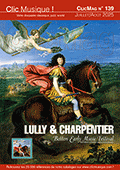|
|

Diapason de février 2021
Critique de Jean-Christophe Pucek
Page n° 79
Classica de mars 2021
Critique de Jérémie Bigorie
Page n° 109
Format : 1 CD Digipack
Durée totale : 00:57:20
Label : Raumklang
Référence : RK3903
EAN : 4018767039030
Code Prix : DM021A
Année d'édition : 2020
Date de sortie : 28/10/2020
Genre : Classique
|
|
 |
Heinrich Schütz (1585-1672)Geistliche Chor-Musik, SWV 369-397 Ensemble Polyharmonique
Magdalene Harer, soprano
Joowon Chung, soprano
Alexander Schneider, alto
Johannes Gaubitz, ténor
Sören Richter, ténor
Matthias Lutze, basse Juliane Laake, violone en sol
Klaus Eichhorn, orgue
|
 
 Après des incursions dans le répertoire allemand (Hammerschmith, Tobias Michaël, Künstel) et italien (Cavalli, Grandi), l'ensemble Polyharmonique consacre son dernier album à celui qui opéra le mieux la synthèse entre les deux styles : Heinrich Schütz et précisément son recueil intitulé Geistliche Chor-Music 1648 année cruciale qui signe la fin de la guerre de trente ans. Le recueil s'inspire d'ailleurs d'hymnes et de textes bibliques dont le Verleih uns Frieden genädiglich qui pourrait servir de plaidoyer pour la paix. L'ensemble est décrit par Schütz comme un exemple de compositions en contrepoint in stile antico à la manière d'Andréa Gabrieli, il y insère d'ailleurs l'arrangement d'un motet de ce dernier. L'interprétation « historiquement informée » des six chanteurs qui composent l'Ensemble Polyharmonique se caractérise surtout par un équilibre sonore parfait (Clarté de chaque tessiture) et l'absence de tout maniérisme dans l'expression du texte au profit des nuances dynamiques et rhétoriques. La prise de son légèrement réverbérée renforçant cet aspect lumineux, pailleté et vibrant. Une belle réussite discographique. (Jérôme Angouillant)  When in 1648 the great Heinrich Schütz published his “Sacred Choral Music,” German-language sacred music was strongly influenced by the modern and innovative madrigal style from Italy. One spoke of a “strangely charming Italian madrigal manner,” or of a “a strangely delightful kind of madrigal.” Heinrich Schütz, on the other hand, shows how one could write lively polyphony in a pure contrapuntal style without violating the sacrosanct compositional rules of the sixteenth century. On its new recording of the “Sacred Choral Music 1648” by Heinrich Schütz, Ensemble Polyharmonique combines ideas of the German and Franco-Flemish singing cultures into lively poetic interpretations. As a listener, one must perhaps have the courage to let oneself succumb to the “pervasiveness” of this music, a music that does not become boring and time and again opens up to him who engages with it. But in the end, one will be richly rewarded by the greatest enjoyment of art and valuable musical experiences that touch both the heart and spirit.
 |
| . |
 |
|
|
